

A two week Tiger safari in India, that not only includes two of India’s best known Tiger Reserves and National Parks of Kanha and Bandhavgarh, but also includes some of the most famous of India’s cultural highlights, the metropolitan city of Delhi, with the city of the Ganges, Varanasi, the erotic temples of Khajuraho, the Taj Mahal in Agra and the pink city of Jaipur. India’s national parks, are quite different from their counterparts in Africa, but, are exciting nevertheless, and have a unique flora and fauna of their own. While Kanha and Bandhavgarh are best known as Tiger reserves, in addition to the Royal Bengal Tigers, they support a whole lot of other wildlife and endangered species too.
Day 01 – Arrive Delhi
You will be met at the airport by Pan India Tourism representative and transferred to the hotel and assisted with check in formalities.
Delhi is the capital of India, and its third largest city. Delhi consists of two parts – New Delhi, the city created in 1911 as the imperial capital of India by the British and the Old Delhi, the Muslim capital of India between the 17th and 19th centuries. In fact there have been at least eight cities on the site of modern Delhi – the earliest known settlement, Indraprastha, featured in the epic Mahabharata over 3000 years ago. Though not always the capital, Delhi has always been an important city of northern region of the subcontinent.
Overnight in Delhi.
Day 02 – In Delhi
After breakfast, you will be picked up from your hotel and taken for a guided sightseeing tour of Old & New Delhi. Tour includes visits to the following places of interest:
Red Fort: Derived from a Hindi word Lal, which means red and Quila which means fort. It is laid out along the river Yamuna as an irregular octagon, surrounded by a wall of about 2.4 kms in circumference and is built of red sandstone. Shah Jahan started construction of the massive fort in 1638 and it was completed in 1648. The fort has two main entrances, the Delhi Gate and the Lahori Gate, which faces the famed Chandni Chowk market. The fort has Diwan – e – Am (hall for public audience); Diwan – e – Khas (hall for private audience); Rang Mahal (a water-cooled apartment of royal ladies); Pearl mosque, built of white marble.
Jama Masjid: In Old Delhi, an architectural extravaganza of Shah Jahan, is the country’s largest mosque where thousands of Muslims offers prayers even today. It was built in 1658. The flight of stairs and its large courtyard are marvels of architecture.
Chandni Chowk (Silver Street): It is the colourful main street and shopping bazaar of Old Delhi and is today one of the country’s best known wholesale market for textiles, electronic goods and watches. The entire area was designed by Jahanara Begum, Shah Jahan’s favourite daughter and was then inhabited by the well-to-do families of the time. Around the area is the famed Paranthawale Gali, known for its delicious paranthas, Dariba Kalan, the gold market and well-known sweetmeats shops.
Raj Ghat : On the banks of river Yamuna, a simple square platform of black marble marks the spot where Mahatma Gandhi was cremated following his assassination in 1948. A commemorative ceremony takes place each Friday, the day he was killed.
Birla Mandir: Close to Connaught Place, it was built by the industrialist Raja Baldev Birla in 1938. The temple is an important prayer site and contains idols of several deities.
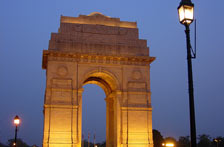 India Gate: This 42 meter high, free standing arch was built in 1931.It was originally called All India War Memorial in the memory of the 90,000 soldiers of the Indian Army who died in World War I. The names of the soldiers are inscribed all along the walls of the arch. In 1971, the eternal flame was lit here to honour the Amar Jawan (Immortal Soldier).
India Gate: This 42 meter high, free standing arch was built in 1931.It was originally called All India War Memorial in the memory of the 90,000 soldiers of the Indian Army who died in World War I. The names of the soldiers are inscribed all along the walls of the arch. In 1971, the eternal flame was lit here to honour the Amar Jawan (Immortal Soldier).
Rashtrapati Bhavan (President’s House): It is the official residence of President of the country. Designed by Lutyens, it was the official residence of the Viceroy when the British ruled India.
Humayun’s Tomb: It was built by Haji Begum (widow of Humayun) in 1565 – 66, nine years after his death.
Qutub Minar: This magnificent structure in the southern part of the capital was built by the Muslim King; Qutab – ud – din Aibak in 1199 A.D. Minar (tower) is 72.5 meters high and has as its base a mosque.
Bahai’s Temple: It is a very recent architectural marvel of the Bahai faith and is visible from several spots in South Delhi. It is a lotus shaped and has rightly been given the name.
Overnight in Delhi.
Day 03 – Fly Delhi - Varanasi
After leisurely breakfast at hotel, you will be met by our representative and assisted with check-out formalities. You will then be transferred to the airport in time to board flight for Varanasi.
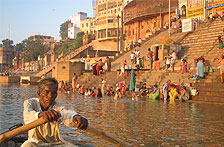 Varanasi - Varanasi, the ‘eternal city’ is one of the most important pilgrimage sites in India and also a major tourist attraction. Situated on the banks of the sacred Ganges, Varanasi has been a center of learning for over 2000 years. Besides being a pilgrimage center, it is considered an auspicious place to die, ensuring an instant route to heaven. Varanasi is still a center of learning, especially for Sanskrit scholars, and students flock here from all over India.
Varanasi - Varanasi, the ‘eternal city’ is one of the most important pilgrimage sites in India and also a major tourist attraction. Situated on the banks of the sacred Ganges, Varanasi has been a center of learning for over 2000 years. Besides being a pilgrimage center, it is considered an auspicious place to die, ensuring an instant route to heaven. Varanasi is still a center of learning, especially for Sanskrit scholars, and students flock here from all over India.
The old city of Varanasi is situated along the west bank of the Ganges and extends back from the riverbank ghats in a winding collection of narrow alleys. They’re too narrow for anything but walking and tall houses overhang the picturesque, though hardly clean, lanes. The town extends from Raj Ghat, near the bridge, to Asi Ghat, near the university.
You will be met at the Varanasi airport by our representative and transferred to the hotel and assisted with check in formalities.
Afternoon, you will be picked up again from your hotel for the guided tour of Varanasi. Tour includes visits following places of interest:
Asi Ghat: It is one of the five special ghats which pilgrims are supposed to bathe from in order and on the same day. The order is Asi, Dasaswamedh, Barnasangam, Panchganga and finally Manikarnika.
Durga Temple: It is commonly known as the Monkey Temple due to the many monkeys that have made it their home. It was built in the 18th century by a Bengali maharani and is stained red with ochre. The small temple is built in North Indian Nagara style with a multi-tiered shikharas (spires). This temple is also closed to non-Hindus, however, you can look down on the temple from a walkway at the top.
Kashi-Vishwanath Or Golden Temple: Dedicated to Vishveswara Siva as the Lord of the Universe, the Golden Temple is across the road from its original position. Aurangzeb destroyed the original temple and built a mosque over it – traces of the earlier 1600 temple can be behind his mosque. The present temple was built in 1776 by Ahalya Bai of Indore, and the gold plating on the towers was provided by Maharaja Ranjit Singh of Lahore. Next to the temple is the Gyan Kupor Well – the well of knowledge. Non-Hindus are not allowed into the temple but can view it from upstairs in a house across the street.
Overnight in Varanasi.
Day 04 - Fly Varanasi – Khajuraho
The day starts early with a Dawn Boat Ride On The Holy River The Ganges. Your guide and driver will pick you up from your hotel and take you to the river Ganges. At dawn, the city and the river are coming alive, the light is magical and Varanasi looks an exotic place. A highlight of any trip to Varanasi - this is an incredible scene, as multitudes of devotees comes to the river to pay homage to the Sun God. The riverfront, as seen from a boat at sunrise, is a spiritually uplifting sight. Hinduism, deep and mystical, is everywhere: in a decorated doorway; in a glimpse of a glittering temple; in the sound of a sacred bell; in the chant of the priests; and in the fragrance of flower oblations.
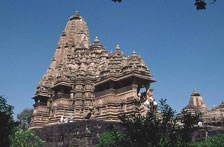
Return to hotel. After leisurely breakfast, you will be met by our representative and assisted with check-out formalities. Then you will be transferred to airport in time to board flight for Khajuraho.
Khajuraho: - Khajuraho was once the capital of the Chandela Rajputs of Bundelkhand. It is home to the world famous 10th century Khajuraho temples. These temples represent some of the most exquisite specimens of medieval Hindu architecture and sculpture in the country.
You will be met at Khajuraho airport by our representative and transferred to hotel and assisted with check in formalities.
No activities are scheduled for this day. Spend rest of the day enjoying the hotel facilities or exploring the city on your own.
Overnight in Khajuraho.
Day 05 - Drive Khajuraho - Bandhavgarh (250 kms / 05 hrs)
After breakfast at hotel, you will be picked up from your hotel and taken for a guided sightseeing tour of Khajuraho Tour includes visits to the following places of interest
Eastern Group Of Temples – It’s includes the Lakshmi and Varaha Temple, the Lakshmana Temple, the Kandariya Mahadev, the Mahadeva Temple; the Devi Jagadamba Temple, the Chitragupta Temple and the Vishwanath Temple.
Western Group Of Temples - Also houses the Matangesvara Temple, the only temple where worship continues and the Chausath Yogini Temple, presently in ruins and believed to be the oldest temple in Khajuraho. The Eastern Group of temples houses the Parasvanath Temple, the largest and finest Jain temple in the city as well as the Adinath Temple, the Shantinath Temple, the Ghantai Temple, the Javari Temple, the Vamana Temple and the Brahma and Hanuman Temple.
Later in the afternoon, you will be met by our representative at hotel and assisted with check out formalities. You will then start your drive to Bandhavgarh, the first of the National parks that you visit on your India tiger safari.
Bandhavgarh National Park - Situated in Central India is one of the most recently declared reserve under India’s most successful conservation project called “Project Tiger”. Formerly a Royal hunting reserve of the princely state of Rewa where the first White Tiger in the wild was ever found. The Bandhavgarh National Park abounds in many of India’s rare and endangered animals: Chital, Sambar, Muntjak (Barking Deer), Nilgai, Chinkara, Chowsingha (Four-horned antelope), Gaur (the Largest Oxen), Sloth Bear, Wild Boar, Leopard and Tiger. Bandhavgarh is undoubtedly one of the best reserve for seeing Indian Tiger. It has vast variety of bird life. For over 275 species of birds are found here such as Horn Bills, Golden Orioles, parakeets, Peacocks, Eagles, and Vultures etc. The Park is situated in 450 Sq. Kms of mixed forest with major Tree being Sal (Shorea robusta) tree and Bamboo. Many of the valleys have meadows, which form the favorite places for most animals. The terrain is undulating with 32 small hills within the Park, the largest and central one abruptly rising 460 meters thus was chosen as the ideal site for Bandhavgarh Fort.
On arrival at Bandhavgarh, check into your Resort.
Overnight in Bandhavgarh.
Day 06 – In Bandhavgarh
Morning and Afternoon Game rides into the Bandhavgarh National Park. Safaris in Bandhavgarh are conducted using Jeeps. Short Elephant rides are also available, for tiger viewing. Resident Naturalists are also at hand, to enhance your safari experience. Overnight in Bandhavgarh.
Overnight in Bandhavgarh.
Day 07 - Drive Bandhavgarh – Kanha (325 kms/06 hrs)
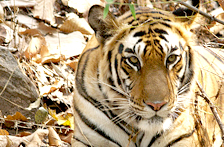 Morning Game ride into the Bandhavgarh National Park. Safaris in Bandhavgarh are conducted using Jeeps. Short Elephant rides are also available, for tiger viewing. Resident Naturalists are also at hand, to enhance your safari experience.
Morning Game ride into the Bandhavgarh National Park. Safaris in Bandhavgarh are conducted using Jeeps. Short Elephant rides are also available, for tiger viewing. Resident Naturalists are also at hand, to enhance your safari experience.
Later, you will drive to Kanha, the second National park that you visit on your India tiger safari.
Kanha National Park is one of the largest National Parks in Asia,and one of the nine original reserves of Project Tiger in 1973.It now boasts the largest population of Tiger in India. The preservation of the barasingha (swamp deer) is one of the park's other success stories, with its population having increased seven-fold in the past 40 years. It is a pretty park with clearly defined areas and a hugely varied topography which comprises hilly areas, thick forest and open meadowland, all of which offer habitat to a wide variety of animals such as chital (spotted deer), langur monkeys, wolves and the elusive leopard.
On arrival at Kanha, check into your Resort..
Overnight in Kanha.
Day 08 –In Kanha
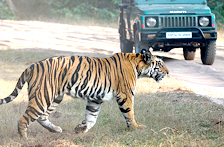 Morning and Afternoon Game rides into the Kanha National Park. Safaris in Kanha are conducted using Jeeps. Short Elephant rides are also available, for tiger viewing. Resident Naturalists are also at hand, to enhance your safari experience. Overnight in Kanha.
Morning and Afternoon Game rides into the Kanha National Park. Safaris in Kanha are conducted using Jeeps. Short Elephant rides are also available, for tiger viewing. Resident Naturalists are also at hand, to enhance your safari experience. Overnight in Kanha.
Return to Resort for breakfast. Later afternoon, you will be picked up again from your Resort and taken for a guided game safari into the Kanha National Park.
Overnight in Kanha.
Day 09 – Drive Kanha – Jabalpur (200 kms / 04 hrs) and overnight train Agra
Morning, game ride in to the Kanha National Park. Safaris in Kanha are conducted using Jeeps. Short Elephant rides are also available, for tiger viewing. Resident Naturalists are also at hand, to enhance your safari experience. Afternoon, drive to Jabalpur and board the overnight train to Agra(1745/0730 hrs).
Overnight on board train.
Day 10 - Arrive Agra
You will be met at Agra Railway Station by our representative and transferred to hotel and assisted with check in formalities
Agra - Agra, situated on the bank of Yamuna River, is home to India’s most famous landmark, the Taj Mahal. Agra was the capital of Mughal Empire in the 16th & 17th centuries and its superb monuments date from this era.
Later in the afternoon, you will be picked up from your hotel and taken a guided sightseeing tour of Agra. Tour includes visits following places of interest:
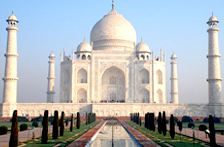 Taj Mahal: The Taj Mahal was constructed by Emperor Shah Jahan in memory of his wife Mumtaj Mahal who died during the birth of her child in 1631. The construction is said to have taken 22 years to complete, starting from 1631, with over 20,000 craftsmen working round the clock. Artisans and experts were brought from France and Italy and the main architect was from Iran.
Taj Mahal: The Taj Mahal was constructed by Emperor Shah Jahan in memory of his wife Mumtaj Mahal who died during the birth of her child in 1631. The construction is said to have taken 22 years to complete, starting from 1631, with over 20,000 craftsmen working round the clock. Artisans and experts were brought from France and Italy and the main architect was from Iran.
Agra Fort: Construction of the massive red sandstone Agra Fort on the bank of Yamuna river was begun by Emperor Akbar in 1565 and it was to be predominantly a military structure until his grandson, Shah Jahan, added more palatial accommodations. There are a number of exquisite buildings within its portals such as Samman Burj, where Shah Jahan was held captive by his son, Moti Masjid, a white marble mosque, Diwan – e – Am, Diwan – e – Khas, Jahangir’s Palace, Khaas Mahal and Shish Mahal.
Overnight in Agra.
Day 11 - Drive Agra – Jaipur (250 kms / 5 hrs)
After breakfast at hotel, you will be met by our representative and assisted with check-out formalities. You will then start your drive to Jaipur. Stop enroute at Fatehpur Sikri for guided tour of this ancient capital.
Fatehpur Sikri: the deserted capital of Emperor Akbar approximately 35 kms outside Agra. Built in the 16th century, this city was abandoned 12 years later due to a scarcity of water. The entire city of Red sand stone (sand stone palaces and temples) is virtually intact and a site worth seeing is the 54 m high main entrance -- The Buland Darwaza, The gate of victory constructed to commemorate Akbar’s victory in Gujarat.
After the visit, continue your drive to Jaipur..
Jaipur - It is the capital of Rajasthan, and known as the “Pink City” because of the pink colored buildings in its old city. It is situated on a dry lakebed in a somewhat arid landscape, surrounded by barren hills surmounted by forts and crenellated walls. Founded in 1727 by Maharaja Jai Singh II, who was careful to cultivate good favour with the ruling Mughals, he laid out the city with rectangular blocks according to ancient Hindu architecture. It is a wonderful city for shopping.
On arrival at Jaipur hotel, you will be met by our representative and assisted with check in formalities.
Rest of the day is at leisure and can be spent enjoying the hotel facilities or exploring the city on your own.
Overnight in Jaipur.
Day 12 - In Jaipur
After breakfast, you will be picked up from your hotel and taken for a guided sightseeing tour of Jaipur and Amber. Tour includes visits to the following places of interest:
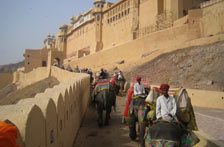 Hawa Mahal (Palace Of Winds): Built by Maharaja Sawaj Pratap Singh in 1799, the Hawa Mahal is one of Jaipur’s major landmarks, the facade of which is all pink windows and filigree screens. It was originally built to enable ladies of the royal household to watch the everyday life and processions of the city.
Hawa Mahal (Palace Of Winds): Built by Maharaja Sawaj Pratap Singh in 1799, the Hawa Mahal is one of Jaipur’s major landmarks, the facade of which is all pink windows and filigree screens. It was originally built to enable ladies of the royal household to watch the everyday life and processions of the city.
City Palace: It is still the home of the former royalty H.H Bhawani Singh Ji of Jaipur housing an extensive collection of art, carpets and old weapons.
Jantar Mantar (Observatory): It was built by Maharaja Jai Singh in 1728. At first glance, Jantar Mantar appears to be a curious collection of sculptures but in fact each construction has a specific purpose such as measuring the positions of stars, altitudes and azimuths, and calculating eclipses. The most striking instrument is the sundial with its 27 meter high gnomon. The shadow this casts moves up to 4 meter an hour.
Amber Fort: The Amber Fort is situated 11 kms away from Jaipur. Amber was once the ancient capital of Jaipur state. The Fort is a superb example of Rajput architecture, stunningly situated on a hillside and overlooking a lake, which reflects its terraces and ramparts. The climb to the fort is on gaily-bedecked elephants.
Overnight in Jaipur.
Day 13 - Drive Jaipur - Delhi (250 kms/05 hrs) and depart Delhi
After leisurely breakfast at hotel, you will be met by our representative and assisted with check out formalities. You will then start your drive to Delhi's International Airport in time for your flight home.
Period |
Standard |
Deluxe |
Elite |
Valid from 01st Oct to 30th June |
US$ 1898 Per Pax |
US$ 2167 Per Pax |
US$ 2730 Per Pax |
Domestic airfare |
US$ 280 Per Pax |
US$ 280 Per Pax |
US$ 280 Per Pax |
Cities |
Standard |
Deluxe |
Elite |
Delhi |
The Conanught |
The Claridges |
Taj Palace |
Varanasi |
HHI Varanasi |
Radisson |
Taj Gateway |
Khajuraho |
Ramada |
Radisson |
Taj Chandela |
Bandhavgarh |
Tiger Den |
Kings Lodge |
Bandhav Vilas |
Kanha |
Chitvan Jungle Lodge |
Chitvan Jungle Lodge |
Singinawa Jungle Lodge |
Agra |
Howard Plaza |
Taj Gateway |
ITC Mughal |
Jaipur |
Shahpura House / Alsisar Haveli |
Lemon Tree Premier |
Jai Mahal Palace |
Small supplements may apply for travel between 23rd October and 30th October, 05th November and 20th November, 20th December and 05th January and during the month of February.
Note: All the figures quoted above are nett per person in US Dollars.
Inclusions:
Pan India Tourism
Unit of - AABYO SWACH YATRA HOSPITALITY PVT. LTD
Phone: 044-43595695
Cell: +91-75 300 25 888,
+91-9789930293, +91-9789080806, +91-9746125967
email: info@panindiatourism.com



